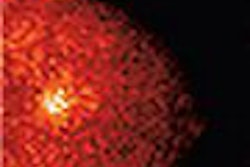Reaching a step beyond clinical cardiac risk predictors, adenosine 99mTc sestamibi myocardial perfusion SPECT appears to be a helpful tool for determining the treatment needs of heart attack survivors, according to researchers from Texas.
The findings of the study, known as INSPIRE (AdenosINe Sestamibi Post-InfaRction Evaluation) were presented at the 2004 American College of Cardiology meeting in New Orleans.
"INSPIRE demonstrated that adenosine 99mTc sestamibi myocardial perfusion tomography (SPECT) can be performed safely very early (i.e., within the first several days) after admission for acute myocardial infarction, and can be used to identify low- and high-risk groups based on the size of the adenosine-induced left ventricular perfusion defect size, and the extent of scintigraphic ischemia," said principal investigator Dr. John Mahmarian, an associate professor of medicine at Baylor College of Medicine in Houston. He is also the assistant director of the Nuclear Cardiology Laboratory at The Methodist Hospital in Houston.
Mahmarian and colleagues conducted a prospective multicenter randomized trial of 728 patients, all of whom had suffered myocardial infarction and were subsequently stabilized. The patients also underwent a baseline MPI (with adenosine and sestamibi) within ten days of the cardiac event.
The patients were then classified into categories of low, intermediate or high risk of suffering a secondary heart attack. Individuals considered at high risk were randomly assigned to either nonsurgical drug therapy or coronary revascularization. Following each procedure or treatment, a second MPI was performed.
Mahmarian declined to share the specific results of the study, but said that they "would be crucial to guiding patient management." Based on their INSPIRE test, low-risk patients are less likely to have a cardiac event and would not necessarily benefit from coronary angiography or revascularization. Conversely, high-risk patients by SPECT should be selected for intensive anti-ischemic drugs or coronary revascularization, Mahmarian said.
"INSPIRE demonstrated the superiority of adenosine SPECT in risk stratification beyond clinical parameters, such as the TIMI risk score, and within all TIMI risk strata (low, intermediate and high). INSPIRE also demonstrated that sequential adenosine SPECT imaging can effectively monitor changes in myocardial ischemia following anti-ischemic medical and revascularization strategies," Mahmarian said.
By Jerry IngramAuntMinnie.com contributing writer
May 20, 2004
Related Reading
Electrocardiographic imaging helps probe arrhythmias, March 16, 2004
TDI acts as potential predictor of chronic congestive heart failure, March 11, 2004
Myocardial perfusion imaging shows promise in first-time heart failure, March 9, 2004
Copyright © 2004 AuntMinnie.com




















